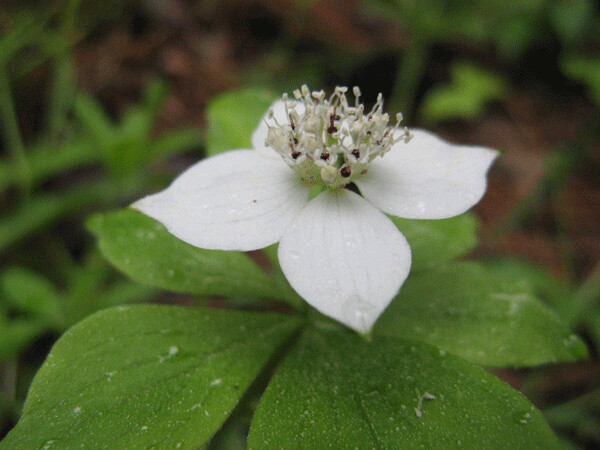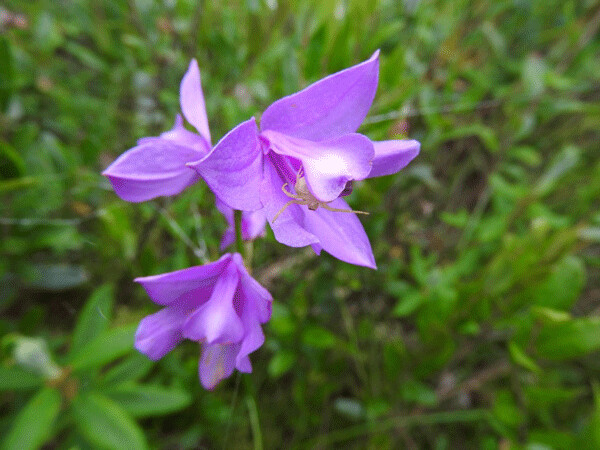Summer Blooms

Well, by the time you read this I will have returned from a nine-day trip in Costa Rica with a group of Museum members. While I’m off gallivanting in a tropical rainforest, I thought I’d give my readers a short break from the winter weather, too. Please enjoy this little taste of summer from June 2017. I’ll have more tropical reports when I return!
On a recent mountain bike ride with a group of women, I quickly fell behind the lead group while easily staying far ahead of the beginner group. Alone in the forest on the first hot day, it was bliss. The Makwa Trail flowed gracefully through deciduous woods south of Seeley, WI, and as evening fell, I wallowed in the rich smells of the summer woods.
Riding alone allowed me to stop and smell the roses. The bright white flowers of wild strawberries and the canary yellow flowers of barren strawberry (both in the Rose Family) lined the trail. The first produces a juicy red berry, the second, despite its similar set of three toothy leaves and five-petaled flowers, only makes a few dry seeds. Trilliums, violets, starflowers, bluebead lily, and a late-blooming wood anemone also caught my eye.
I’m pretty sure that Lois Nestel, the Museum’s first naturalist and director, would never have joined me on a mountain bike ride, but I know I would have loved walking attentively through the woods with her. This week, I’d like to share her description of the residents of woods and fields as summer begins to bloom. Slow down a minute with me, we’ll smell the roses, and I think you’ll find it rewarding.
Lois wrote, “Although the woodland flowers of spring are passing as increased foliage cuts off the light, there are still numbers of delightful varieties to be found. Both pink and yellow lady-slippers are blooming now as are some of the bog orchids. Many smaller shade-loving blooms may also be found if one cares to expend the extra energy to find them. Dainty gold-thread, pipsissewa, and twinflowers lift their lovely blooms only two or three inches above the forest duff. The dwarf dogwood, known as bunchberry, masses its four-petaled green and ivory flowers along banks and around old stumps, and nearby the yellow bloom of Clintonia or bluebead lily may be found.

“But from now until autumn the floral emphasis will be upon the blossoms of open areas, roadsides, fields and glades—and the variety seems endless. Drifts of color along roadsides and in meadows are more spectacular than are the more modest flowers of spring. Daisies, hawk-weed, and other composites now dominate the scene, and the yellow-flowered salsify, best known in late summer for its huge dandelion-like seed head (commonly known as goat’s beard), is one of the most interesting. It is related to the oyster plant grown in gardens.
“Perhaps the loveliest flower of the season is the wild rose, and differences in varieties and habitat allow their season to be quite extended. While color may vary from deep pink to almost white, the typical rose fragrance varies little. Simple perfection personifies the rose.
“In damp meadows, golden alexanders spread their wheels and along the edges, in sheltered nooks, wild columbine nods its spurred bells. In drier fields and roadsides, flat-topped aromatic heads of yarrow vary from dingy white to mauve or pink. From hillside to hallow, from northern to southern exposure, great differences can be seen in the development of the floral community. In sunny, open areas some plants will already be seeding while their counterparts in cool depressions are only in bud.
“Summer’s profusion together with our modern way of life can be a disadvantage. Traveling swiftly by car, one sees sheets and belts and blurs of color…sees and yet does not see. The quantity bedazzles, the quality is not seen.
“Take time to walk, to examine the intricacies of the individual flower; look for the less obvious. It is rewarding.”
Special Note: Emily’s book, Natural Connections: Exploring Northwoods Nature through Science and Your Senses is here! Order your copy at http://cablemuseum.org/natural-connections-book/. Listen to the podcast at www.cablemusum.org!
